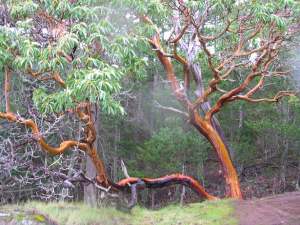 This Wednesday, we had our tenth Ethnobotany Apprenticeship class with Earthwalk Northwest. JT introduced today’s mystery plant: Pacific Madrona. She made a tea infusion with bark, leaves and flowers. JT brought leaves, bark and blossoms and a beautiful wooden bowl. The tea was mild and astringent, the blossoms sweet. Medicinally, the bark tea can be used for colds and stomach issues. Its hard wood was used by native people for gambling sticks, bowls and necklaces. Pacific Madrona, Arbutus menziesii, is part of the Heath, Ericaceae, family. The tree grows from Vancouver Island, south through the Cascade lowlands all the way down to San Diego County. Madrone berries are prized as by birds, rodents, deer, and wood rats.
This Wednesday, we had our tenth Ethnobotany Apprenticeship class with Earthwalk Northwest. JT introduced today’s mystery plant: Pacific Madrona. She made a tea infusion with bark, leaves and flowers. JT brought leaves, bark and blossoms and a beautiful wooden bowl. The tea was mild and astringent, the blossoms sweet. Medicinally, the bark tea can be used for colds and stomach issues. Its hard wood was used by native people for gambling sticks, bowls and necklaces. Pacific Madrona, Arbutus menziesii, is part of the Heath, Ericaceae, family. The tree grows from Vancouver Island, south through the Cascade lowlands all the way down to San Diego County. Madrone berries are prized as by birds, rodents, deer, and wood rats. 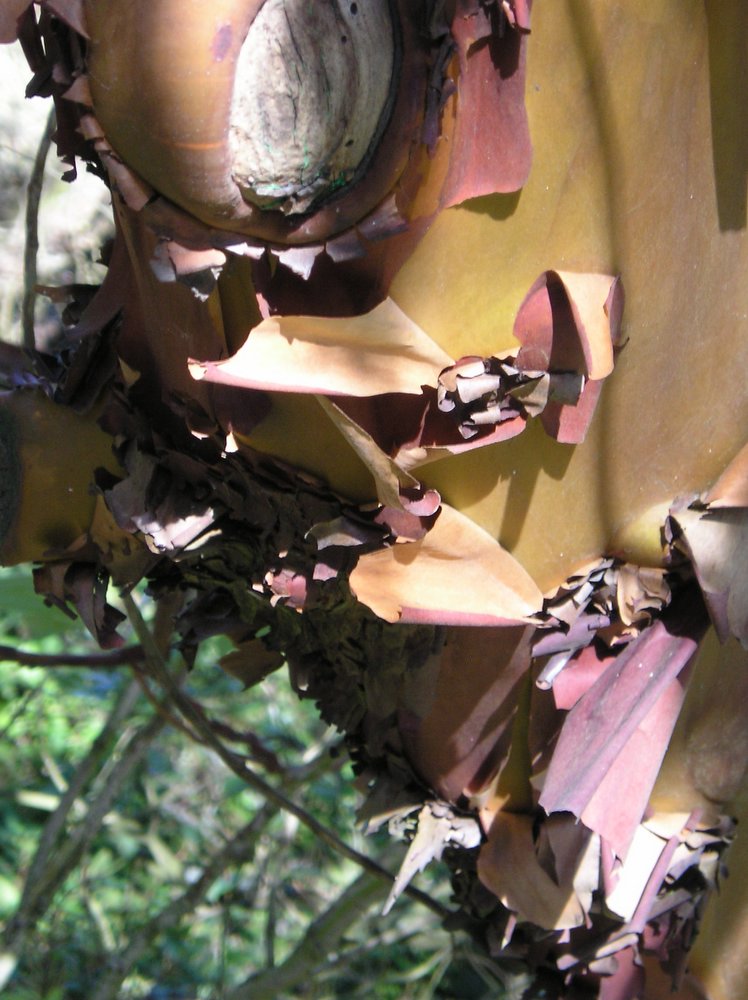 At least five species of birds, especially the mourning dove and band-tailed pigeon, devour berries and then disseminate the seeds. According to the U.S. Forest Service, “. . . the longevity of madrone is not known, the species has been referred to as “giving evidence of being long lived.” Trees 200 to 250 years old have been recorded and large specimens are estimated to be 400 to 500 years old.” I remember seeing its beautiful rusty skin peeling down its smooth slender trunk along the Marin County coastal bluffs and in the lowland areas around Yosemite National Park.
At least five species of birds, especially the mourning dove and band-tailed pigeon, devour berries and then disseminate the seeds. According to the U.S. Forest Service, “. . . the longevity of madrone is not known, the species has been referred to as “giving evidence of being long lived.” Trees 200 to 250 years old have been recorded and large specimens are estimated to be 400 to 500 years old.” I remember seeing its beautiful rusty skin peeling down its smooth slender trunk along the Marin County coastal bluffs and in the lowland areas around Yosemite National Park.
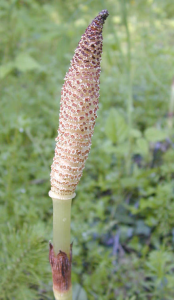 Jonas brought a mystery powder. He took a small tin from his pocket and emptied a green powder on a piece of paper. He gave us hints, reminding us that we had gathered some of the plant last week. It comes from a family of vascular plants that reproduce by spores rather than seeds. After stumping us he told of picking a horsetail in the rain to take home and draw. He set it out over night and the next day the flower had dropped the spores!
Jonas brought a mystery powder. He took a small tin from his pocket and emptied a green powder on a piece of paper. He gave us hints, reminding us that we had gathered some of the plant last week. It comes from a family of vascular plants that reproduce by spores rather than seeds. After stumping us he told of picking a horsetail in the rain to take home and draw. He set it out over night and the next day the flower had dropped the spores!
This is the Giant Northern Horsetail, Equisetum telmateia, part of the Horsetail, Equisetaceae, family. It is considered a living fossil, surviving member of a class which dominated the understory of late Paleozoic forests. Somer grew as large trees nearly 100 feet tall. Last week Karen picked one on our walkabout. She peeled it back and took a bite of the stalk which tastes like celery. Medicinally, the plant is astringent and diuretic. (Astringents are herbs that dry, draw, or shrink tissue, which helps to create a barrier.) It can be consumed as a decoction (boiling plant material in water). Its chopped plant material can be used topically as a poultice.
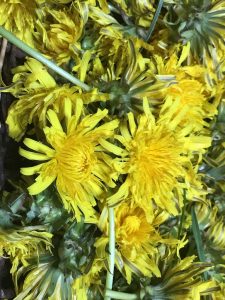 We had an ambitious plan for the rest of the day: Harvest enough dandelion blossoms to make dandelion wine. Bottle the nettle ale we made last week. Prepare a feast of wild foods including the beautiful oysters and clams Jonas harvested during yesterday’s minus tide.
We had an ambitious plan for the rest of the day: Harvest enough dandelion blossoms to make dandelion wine. Bottle the nettle ale we made last week. Prepare a feast of wild foods including the beautiful oysters and clams Jonas harvested during yesterday’s minus tide. 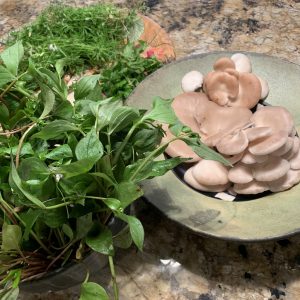 I brought a basket of oyster mushrooms, Pleurotus ostreatus, I gathered in the woods not far from home. JT brought beautiful salad greens adorned by violet flowers.
I brought a basket of oyster mushrooms, Pleurotus ostreatus, I gathered in the woods not far from home. JT brought beautiful salad greens adorned by violet flowers.
We continued our day with a foraging trip to collect dandelion blossoms in the rain. Dandelion was our mystery plant for the third week of class. We tromped around in the rain looking for open blossom faces. 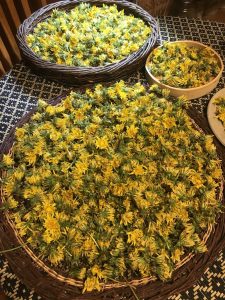 Back in the kitchen we spread them out on baskets under a warm bright light to encourage further opening.
Back in the kitchen we spread them out on baskets under a warm bright light to encourage further opening. 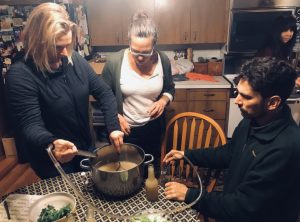 While the blossoms were drying we bottled the nettle ale we made in last week’s class. Karen worked the kitchen like an orchestra conductor:
While the blossoms were drying we bottled the nettle ale we made in last week’s class. Karen worked the kitchen like an orchestra conductor:
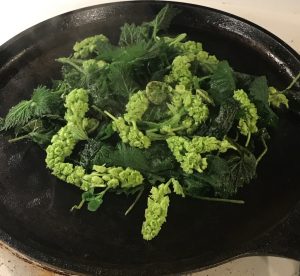
We chopped oyster mushrooms, maple blossoms, nettles, onions and garlic.
We sautéd oysters in wine and garlic and steamed the clams with herbs. JT assembled a magical wild salad. 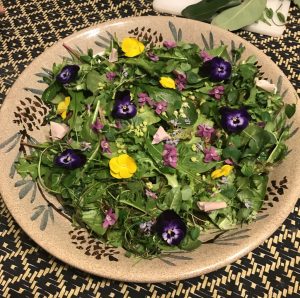 The foods were assembled and savored to be served with dandelion wine. We feasted. It’s hard to convey what the attention and care many hands can create.
The foods were assembled and savored to be served with dandelion wine. We feasted. It’s hard to convey what the attention and care many hands can create.
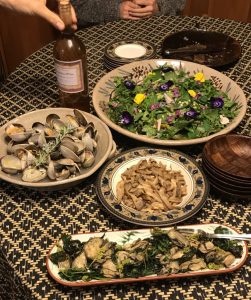
After lunch we started the patient task of extracting all the little dandelion petals from their green crowns. This gave us a bit of sharing time and yellow fingers.
In the meantime, Karen was “cooking” honey in water to encourage bits of beeswax to rise and be skimmed off the surface of the honey to be used in our wine. 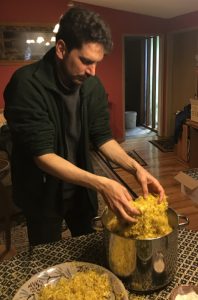
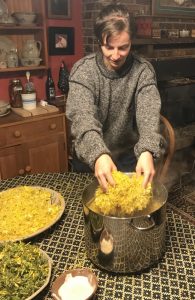 Petals were placed in the pot. Yeast was fed with orange juice. Everything came together to grow into liquid beauty in a few days time. In fact one of the best “secret” ingredients of food and life is time. Learning about and relating to our natural world and to each other takes time. What a gift we give ourselves!
Petals were placed in the pot. Yeast was fed with orange juice. Everything came together to grow into liquid beauty in a few days time. In fact one of the best “secret” ingredients of food and life is time. Learning about and relating to our natural world and to each other takes time. What a gift we give ourselves!
